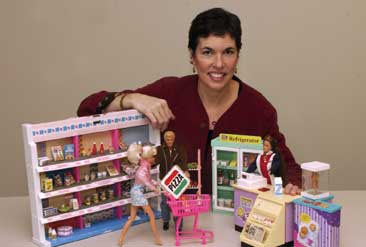
TOPIC: Barbie "Buys" Booze and Butts
I heard about this story yesterday on the radio talk show, PrimeTime America. After pulling my mouth closed from astonishment, I went home and talked with my kids about their TV and music habits. THANKFULLY, we do not have a problem with these things -- and no one in our home drinks or smokes. The larger issue ISN'T the use of alcohol or tobacco. The larger issue is that kids will do what their parents and peers do. What goes in, will come out -- one way or another. Here's the article from Dartmouth Medicine:
"Where's the beer, beer, beer?" That's no fraternity chant. It's what a young child wanted to know while "shopping" for an evening with friends as part of a DMS study. The results, published in the Archives of Pediatrics & Adolescent Medicine, suggest that preschoolers have already formed attitudes about smoking and drinking.ABCNews added in its coverage of the study:
The study involved a role-playing scenario in which 120 children, aged two to six years, used Barbie and Ken dolls to purchase items from a toy grocery store in preparation for an evening with friends. The store was stocked with 70 different miniature products, including vegetables, meat, fruit, candy, milk, desserts, medicine, cereal, cigarettes, beer, and wine.
About 62% of the children bought beer or wine, and 28% bought cigarettes. "I didn't expect such a high percentage of children to buy alcohol or cigarettes," says study leader Madeline Dalton, Ph.D., a research associate professor of pediatrics at DMS and director of the Hood Center for Children and Families at Dartmouth. "Overall, I think it shows that very young children perceive alcohol and tobacco as appropriate and normal in social situations."
Children were more likely to buy cigarettes if their parents smoked and more likely to buy alcohol if their parents drank more than once a month. Most studies that examine early attitudes toward smoking and drinking are focused on older children. But this one, which was funded by the Robert Wood Johnson Foundation, suggests that attitudes may form at a much younger age than previously thought. "It's difficult to have an impact on middle school-age children with prevention programs if you are getting to them 10 years after they've already formed their attitudes," Dalton points out.
The study certainly suggests that alcohol and tobacco prevention efforts may need to be targeted toward younger children and their parents. But the results need to be confirmed by larger studies. "I was surprised it received as much media coverage as it did," observes Dalton, "because it was a pilot study" with a relatively small number of research subjects. "But," she adds, "I think it opens a lot of doors for future research."
Children who watched adult-content movies were five times more likely to buy alcohol, but the researchers did not find a statistically significant link between movie-watching and choosing cigarettes. The study suggests that parents should be careful about the movies their children watch, said Craig Anderson, who studies media violence at Iowa State University. "Kids are basically little learning machines. Whatever the content is in front of them, they're going to pick it up," Anderson said.
The children in the study were mostly white and their parents were mostly college educated. Smoking rates were lower among the parents than in the general population, but alcohol use was fairly high, Dalton said. A random sample would have made the findings more relevant to the general population, she said.



No comments:
Post a Comment